“Global AI in Home Healthcare Market to reach a market value of USD 36.1 Billion by 2031 growing at a CAGR of 53.2%”
The Global AI in Home Healthcare Market size is expected to reach $36.1 billion by 2031, rising at a market growth of 53.2% CAGR during the forecast period.
AI technologies, including machine learning and natural language processing, are becoming more sophisticated, enabling better analysis of patient data. Thus, the patient data and risk analysis segment acquired $245.3 million revenue in 2023. These advancements allow healthcare providers to extract valuable insights from patient data collected at home, leading to more accurate risk assessments and personalized care plans. Thus, these aspects will assist in the expansion of the segment.
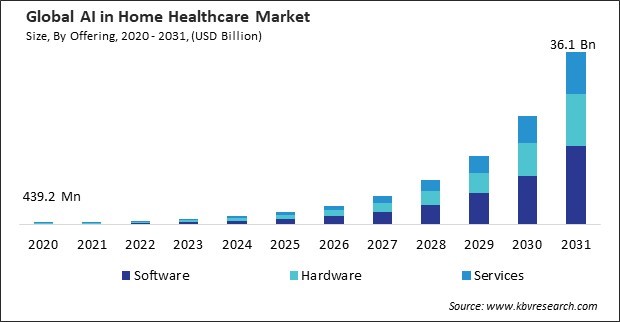
The major strategies followed by the market participants are Partnerships as the key developmental strategy to keep pace with the changing demands of end users. For instance, In, March 2024, GE HealthCare Technologies, Inc. came into partnership with Mass General Brigham. Through this partnership, GE HealthCare would incorporate foundational models for medical imaging into their AI research endeavors, emphasizing a robust commitment to responsible AI principles. Additionally, In, December 2023, Medtronic PLC came into partnership with Cosmo Intelligent Medical Devices. Through this partnership, Medtronic would revolutionize the field of endoscopy through the utilization of AI, aiming to enhance patient outcomes.
Based on the Analysis presented in the KBV Cardinal matrix; F. Hoffmann-La Roche Ltd. is the forerunners in the Market. In February 2024, F. Hoffmann-La Roche Ltd. came into partnership with PathAI, a US-based biotechnology company. Through this partnership, Roche would create AI-powered digital pathology algorithms for RTD's companion diagnostics division. Companies such as Medtronic PLC, Siemens Healthineers AG, and GE HealthCare Technologies, Inc. are some of the key innovators in Market.
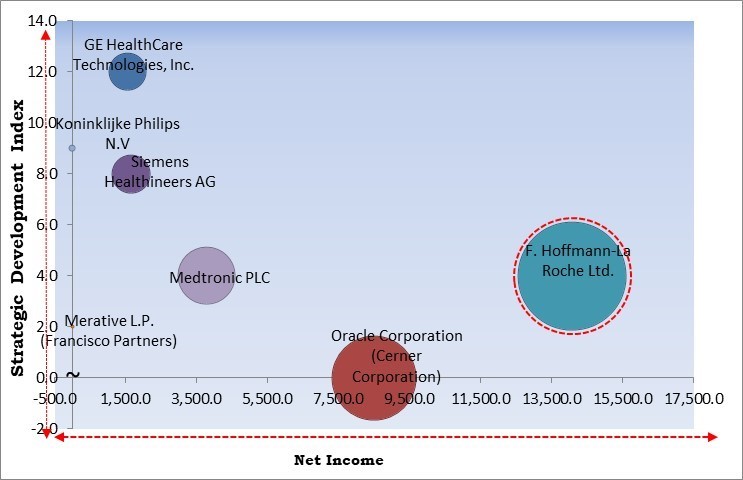
One significant impact of COVID-19 was the increased reliance on telehealth and remote monitoring solutions to ensure continuity of care while minimizing exposure to the virus. AI-driven telehealth platforms enabled healthcare providers to conduct virtual consultations, monitor patients remotely, and deliver personalized care from a distance. Hence, the COVID-19 pandemic positively impacted the market.
AI algorithms can analyze complex medical data, including images, patient records, and genetic information, with unprecedented speed and accuracy. This enables home healthcare devices to provide more accurate diagnoses, leading to timely interventions and improved treatment outcomes. Therefore, these aspects will pose lucrative growth prospects for the market.
Additionally, Wearable sensors can continuously monitor physiological parameters such as heart rate, blood pressure, blood glucose, and activity levels. This real-time monitoring enables patients to track their health status continuously, providing valuable insights into their well-being and allowing for early detection of any abnormalities or health issues. Hence, owing to these factors, there will be enhanced demand for AI in home healthcare.
Achieving interoperability among diverse platforms and technologies in home healthcare settings is crucial for facilitating seamless data exchange and collaboration among caregivers. Home healthcare environments often involve various EHR systems, medical devices, and AI solutions, each with data formats, protocols, and standards. Thus, these aspects can hamper the growth of the market.
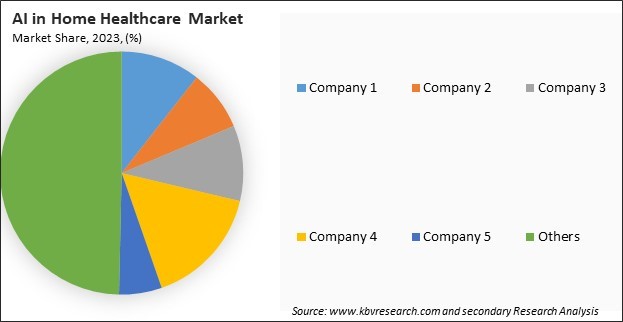
The leading players in the market are competing with diverse innovative offerings to remain competitive in the market. The above illustration shows the percentage of revenue shared by some of the leading companies in the market. The leading players of the market are adopting various strategies in order to cater demand coming from the different industries. The key developmental strategies in the market are Partnerships & Collaborations.
On the basis of technology, the AI in home healthcare market is divided into machine learning, natural language processing, context-aware computing, and computer vision. The machine learning segment recorded a 42% revenue share in the AI in home healthcare market in 2023. Machine learning algorithms can analyze real-time data from wearable devices, sensors, and other remote monitoring devices used in home healthcare.
Based on application, the AI in home healthcare market is divided into patient data & risk analysis, lifestyle management & remote patient monitoring, virtual assistants, wearables, mental health, and others. The virtual assistants segment procured a promising growth rate in the AI in home healthcare market in 2023. Virtual assistants integrated with AI technology can remotely monitor patients' vital signs, medication adherence, and overall health status.
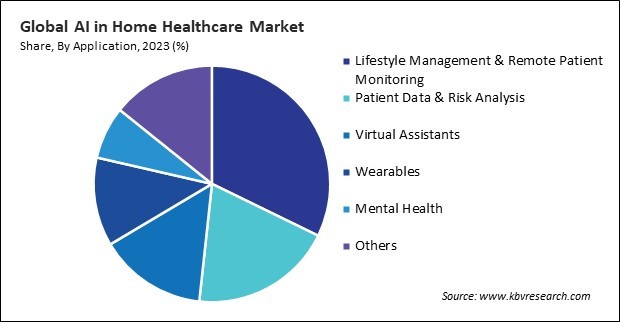
On the basis of end user, the market is divided into healthcare providers, healthcare payers, patients, and others. The healthcare providers segment recorded a 45.2% revenue share in the market in 2023. AI algorithms can analyze large volumes of patient data to generate personalized treatment plans tailored to individual patient's needs and preferences.
Based on offering, the AI in home healthcare market is segmented into software, hardware, and services. In 2023, the hardware segment garnered a 30.5% significant revenue share in the AI in home healthcare market. The hardware segment includes wearables, sensors, smart monitors, and home healthcare kits with AI capabilities.
Free Valuable Insights: Global AI in Home Healthcare Market size to reach USD 36.1 Billion by 2031
By region, the market is segmented into North America, Europe, Asia Pacific, and LAMEA. The North America segment procured a 42% revenue share in the market in 2023. North America, particularly the United States, is a technological innovation and development hub.
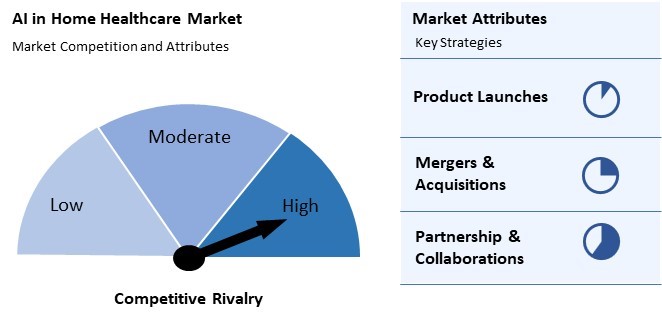
Competition in the AI in home healthcare market is fierce, driven by major tech firms like F. Hoffmann-La Roche Ltd. and startups. Established healthcare IT companies also vie for dominance, alongside providers and insurers embracing AI. Regulatory hurdles shape the landscape. Innovation, collaboration, and regulatory navigation define the dynamic ecosystem seeking to revolutionize home healthcare.
| Report Attribute | Details |
|---|---|
| Market size value in 2023 | USD 1.3 Billion |
| Market size forecast in 2031 | USD 36.1 Billion |
| Base Year | 2023 |
| Historical Period | 2020 to 2022 |
| Forecast Period | 2024 to 2031 |
| Revenue Growth Rate | CAGR of 53.2% from 2024 to 2031 |
| Number of Pages | 356 |
| Number of Tables | 573 |
| Report coverage | Market Trends, Revenue Estimation and Forecast, Segmentation Analysis, Regional and Country Breakdown, Competitive Landscape, Market Share Analysis, Porter’s 5 Forces Analysis, Company Profiling, Companies Strategic Developments, SWOT Analysis, Winning Imperatives |
| Segments covered | Offering, Technology, Application, End User, Region |
| Country scope |
|
| Companies Included | Siemens Healthineers AG (Siemens AG), F. Hoffmann-La Roche Ltd., GE HealthCare Technologies, Inc., Oracle Corporation (Cerner Corporation), Koninklijke Philips N.V, Merative L.P. (Francisco Partners), Medtronic PLC, Sensely, Inc., CarePredict Inc., Qventus Inc. |
By Offering
By Technology
By Application
By End User
By Geography
This Market size is expected to reach $36.1 billion by 2031.
Advancements in AI and machine learning technologies are driving the Market in coming years, however, Interoperability and integration issues of AI in home healthcare restraints the growth of the Market.
Siemens Healthineers AG (Siemens AG), F. Hoffmann-La Roche Ltd., GE HealthCare Technologies, Inc., Oracle Corporation (Cerner Corporation), Koninklijke Philips N.V, Merative L.P. (Francisco Partners), Medtronic PLC, Sensely, Inc., CarePredict Inc., Qventus Inc.
The expected CAGR of this Market is 53.2% from 2024 to 2031.
The Lifestyle Management & Remote Patient Monitoring segment is leading the Market by Application in 2023; thereby, achieving a market value of $11 billion by 2031.
The North America region dominated the Market by Region in 2023, and would continue to be a dominant market till 2031; thereby, achieving a market value of $14.3 billion by 2031.
Our team of dedicated experts can provide you with attractive expansion opportunities for your business.
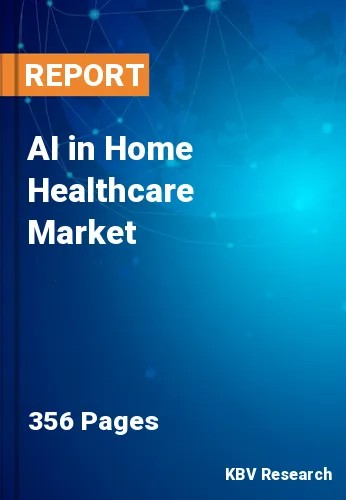
 Drivers
Drivers
 Restraints
Restraints
 Opportunities
Opportunities
 Challenges
Challenges
